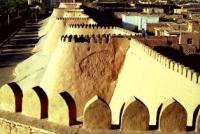You are here
Khiva framed by ancient Khorezm.

Excursions on architectural monuments of Khiva.
“One night a thief got to Khoja. Having clambered the whole house and, finding nothing, the thief took the old chest of drawers and left. Going to the door of his house, he suddenly saw in horror that a sleepy Hodge followed him with a mattress and a blanket.
- Where are you going? - confused thief.
- How where? - Khoja answered perplexedly, “aren't we moving here?”
100 stories about Khoja Nasreddin.
Trip to Khiva from Astrakhan.
Khiva is also in a list of historical cities of Uzbekistan which once was a capital of longstanding states of Kharezm as well as the Khanate of Khiva. And it has still been remaining as the capital city of the present day Kharezm province.
Furthermore, Khiva is the first World Heritage Site in Uzbekistan which was designated by the UNESCO in 1991. Although Khiva was primarily mentioned in manuscripts of Muslim travelers, according to archeological evidence the existence of Khiva goes back to the V - VI centuries.
In accordance with some legends, the origination of the name of the city is connected to the well “Hivak” (or “Heivak”) which is situated in the historical part of it. But trustworthy information about Khiva was met in Arabic and Persian historical-geographical inscriptions from the X century.
Until the fifth century BCE Khiva as well as Kharezm was under the control of the Akhmanids. When Kharezm became an independent state, Khiva was annexed in it. At the beginning of the fourth century Khiva with Kharezm as appended to the Sassanids’ state and during the period it was surrounded with a wall. In 712 it was conquered by the Arabs. Subsequently, in 1221 the city was subjugated by the Mongols Empire.
Khiva was in a territory of Chigatai Khanate where the capital was at Old Urgench after the Mongols invasion and it was regarded as one of the most significant and largest trade centers in Central Asia.
But in 1388 it was completely demolished. At last in 1511 Yadgari Shaybanids declared themselves as the khans of the region. In 1619 according to the decision of Arab Muhammad I Khiva became the capital of the khanate owing to fully abandonment of Old Urgench in 1576.
The Khanate of Khiva, the historical state name of Central Asia existed from 1511 to 1920 excepting the period of the Persian Nadir Shah’s occupation from 1740-1746. The country with its capital in Khiva city was governed by the Kungrads, a branch of the Astrakhans, a Genghis dynasty.
In 1873 the Khanate of Khiva was made as Russian protectorate. In respect of the October Revolution in 1917 the Khanate of Khiva as well as Khiva was also included in it and as a result of it was replaced with Khorezm People’s Soviet Republic.
In 1924 it was formally incorporated into the former USSR as a part of the Uzbek Soviet Socialist Republic. And currently the area occupies large parts of Karakalpakistan and Kharezm province of present day Uzbekistan.
Khiva is divided into two parts such as outer town (Dishan Kala) and inner town (Ichan Kala). The Dishan Kala was defended by a wall with 11 gates while the Ichan Kala was surrounded by a brick wall with 4 gates.
The base of the wall is supposed to have been laid in the tenth century. The walls with approximately 10 meter height which have still been preserved were built in the seventeenth century.
More than 50 historical memorials and monuments as well as about 250 old houses have still been preserved in the old town. Most of them were built in the eighteenth and nineteenth centuries.
For example, one of them is Djuma Mosque founded in the tenth century which is presently located in Ichan Kala. Despite of the reconstruction in 1788 - 1789, some part of the building with 112 columns haven’t been touched as an ancient structure.
Being popular with the name of “Museum under the Open Sky”, Khiva comprises almost all historical monuments and memorials and here below are listed many of them:
Ichan - Kala, (late XVIII c. - early XIX c.),
Madrasah of Allahkulikhan (1834 - 1835),
Madrasah of Kutlug-Murad-Inak (1804 - 1812),
Tim and Caravansary of Alla-Kuli-Khan (XIX c.),
Madrasah of Abdullakhan (1865),
The Mosque and Chambers of Anush Khan (1657),
Tash-Hauli Palace (1830 - 1836),
The mosque Ak-Mosque (1832 - 1842),
Djuma Mosque and Minaret (1788 - 1789),
Mausoleum of Said Allauddin (XIV c.),
Madrasah of Muhammad Amin Khan (1851 - 1852),
Minaret Kalta Minor (1855),
Kunya-Ark (1868 - 1888),
The Minaret of Tura-Murat-Tur (1888),
Madrasah of Muhammad Amin Khan (1871),
Madrasah of Shergazi Khan (1718 - 1720),
Mosque of Baglandi (XIX c.),
Madrasah of Arabkhan (1838).
Authority:
«Khiva city and legends» the tourist guidebook across Khiva”.







